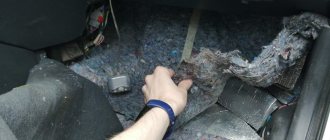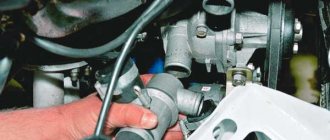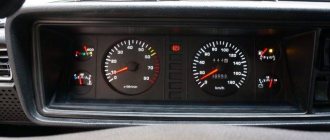A modern car is a reliable, easy-to-maintain, comfortable vehicle for the driver and passengers that can be used in any weather. The car body protects people and things inside from various natural precipitations. The appearance of a leak is a real problem, so you should quickly find out the cause and eliminate the leak.
Often this problem is solved experimentally. Water often gets inside the trunk through hidden routes. This means that you need to look in places that are potentially weak for leaks.
If there is water in the trunk of a Priora, Kalina or Grants
| Initially, the owners began to notice water in the trunk of Kalina and Priora hatchback/station wagon, and later the new Granta liftback inherited this problem. We find out the possible reasons for the appearance of water in the trunk and ways to eliminate this problem. |
If water appears in the trunk of a hatchback or station wagon after a trip in rainy weather, you should check:
- tightness of lanterns.
- tightness of the fifth tailgate and glass, condition of the seals.
- exhaust ventilation valves, which are located under the bumper.
- tightness of the LADA logo fastenings (two holes in the trunk lid). You will need to remove the fifth door trim.
- tightness of the side glazing (a similar problem occurs on the VAZ 2111 and 2112).
You can more accurately determine the source of water entering the trunk with the help of an assistant, who should be in the trunk and observe the appearance of water while driving through puddles.
Another reason for water in the trunk may be natural condensation. In this case, it is necessary to ensure good air circulation in the trunk. To do this, check the operation of the exhaust ventilation and exclude absorbent materials. Or soundproof the trunk (Kalina 2, Lada Granta or Priora).
By the way, do you know why water appears in the cabin of Grants or Kalina 2?
Source
Let's dive in
It also happens that the car is seriously filled with water, for example, overcoming deep puddles or ponds, a significant amount of water spilled in the cabin itself, and all sorts of other extreme situations.
In this case, serious disassembly of the interior of the car is required, since the initially accumulated water must be drained, and then the entire sound insulation, which is very reluctant to part with condensate, must be dried.
To drain water, cars have special drain holes, which, as a rule, are located under the feet of all passengers. Their more specific location can be found in the instruction manual.
When disassembling the interior, you should carefully lay out the removed products so that during assembly no questions arise: what is this?
Thus, even after a severe flooding of the car, you can avoid the formation of mold, and as a result, an unpleasant odor inside the car.
Water in the trunk of a Priora
If earlier climatic conditions were more stable, now the weather never ceases to “delight” us with its changes. Either the heat is unbearable, or the rain does not stop for weeks, which often leads to various floods. The rains are so long and heavy that city streets turn into seething streams.
And real rivers become so overflowing due to heavy rainfall that they overflow their banks, flooding everything in their path. Not only people suffer, but also their property. Quite often, such rains affect cars; water can be unexpectedly found both inside the car and in its trunk.
Russian cars are not highly sealed, so dust, dirt, and water in the trunk of a Priora are a fairly common occurrence. There may be several reasons for this.
— The gap between the trunk and the lid exceeds the permissible standards. This may be due to the cover being displaced or deformed. By eliminating this gap, you will achieve a sealed trunk.
If the cover is displaced, then simply adjust its position through special holes. If deformation occurs, straightening will be required. The result of your actions should be a reduction in the gap and a smooth, unhindered lifting of the luggage compartment.
— The rubber seal on the lid is cracked and unusable. In this case, simply remove it and install a new one.
If water is still found in the trunk of the Priora sedan, then first of all you need to immediately remove the mat and dry it thoroughly, and then find and eliminate the cause of its appearance. In a Priora hatchback, water may be observed in the trunk due to leaky built-in ventilation under the lights. This reason can be eliminated by securing the plastic rectangles with sealant.
If the problem was not limited to a simple puddle in the trunk, and contact with water was closer and longer, then the result may be disappointing. Often the car is simply scrapped, but if the car was partially submerged in water and the water was more or less clean and fresh, then you can try to save it.
You should not try to start the engine until all contaminants are completely removed and the car is dry, as this can only worsen the situation.
First, determine where the water was able to reach. If there is water in the trunk and interior of the Priora, then proceed to drying and cleaning as quickly as possible so that the parts do not become deformed from high humidity and mold and mildew do not develop. For faster results, remove all floor mats and, if necessary, remove seats.
The biggest problems will come from contact of water with electronics. It is very sensitive to moisture, even a small amount of water can cause irreparable damage. Most will have to be completely replaced, but even this does not guarantee that after some time the problem with the electrical system will not arise again.
Source
Harm from dry cleaning
Often, after wet cleaning of the interior, an increased amount of water remains in it, which must be removed before it penetrates into the seals and heat-sound-insulating layers. You should use thick towels and plenty of napkins to remove all unnecessary condensation. The lining of the internal parts should be thoroughly squeezed and wiped with towels. Armchairs and other interior parts need to be squeezed vigorously and any water that comes out must be collected. You can use heavy tool boxes as a press. As a last resort, you can sit on a wet chair and collect the water protruding from the sides.
Some small and hard-to-reach interior items can be freed from water using a hairdryer and devices powered by a cigarette lighter. We direct a targeted flow of warm air from the devices and evaporate the moisture accumulated there.
To speed up the process of drying the car interior, you can use a vacuum cleaner. By turning it to maximum, it will effectively draw water, for example, from rugs or seats. Of course, you cannot achieve a perfectly dry surface using this method, but you can significantly reduce the level of water contained in the products.
Water in the trunk of a Priora
If earlier climatic conditions were more stable, now the weather never ceases to “delight” us with its changes. Either the heat is unbearable, or the rain does not stop for weeks, which often leads to various floods. The rains are so long and heavy that city streets turn into seething streams.
And real rivers become so overflowing due to heavy rainfall that they overflow their banks, flooding everything in their path. Not only people suffer, but also their property. Quite often, such rains affect cars; water can be unexpectedly found both inside the car and in its trunk.
Russian cars are not highly sealed, so dust, dirt, and water in the trunk of a Priora are a fairly common occurrence. There may be several reasons for this.
— The gap between the trunk and the lid exceeds the permissible standards. This may be due to the cover being displaced or deformed. By eliminating this gap, you will achieve a sealed trunk.
If the cover is displaced, then simply adjust its position through special holes. If deformation occurs, straightening will be required. The result of your actions should be a reduction in the gap and a smooth, unhindered lifting of the luggage compartment.
— The rubber seal on the lid is cracked and unusable. In this case, simply remove it and install a new one.
If water is still found in the trunk of the Priora sedan, then first of all you need to immediately remove the mat and dry it thoroughly, and then find and eliminate the cause of its appearance. In a Priora hatchback, water may be observed in the trunk due to leaky built-in ventilation under the lights. This reason can be eliminated by securing the plastic rectangles with sealant.
If the problem was not limited to a simple puddle in the trunk, and contact with water was closer and longer, then the result may be disappointing. Often the car is simply scrapped, but if the car was partially submerged in water and the water was more or less clean and fresh, then you can try to save it.
You should not try to start the engine until all contaminants are completely removed and the car is dry, as this can only worsen the situation.
What to do if there is little moisture
Of course, it is better to prevent the appearance of moisture in the car interior than to deal with it later
Motorists who pay attention to car care to avoid unpleasant consequences are no less concerned about maintaining dryness than replacing consumables
In summer, you can easily provide conditions for quickly removing moisture; to do this, simply open the windows or doors so that warm air flows circulate well. If the car is equipped with a climate control system, then in any bad weather you can organize a suitable microclimate in the cabin. The “Window Defrosting” option will help get rid of excess humidity. Of course, you should not only brush snow off your clothes and shoes when getting into the car, but also use the right mats so that moisture doesn’t have a chance in the first place. In winter, you should not use textile car mats; rubber ones are better for this period, since they are easy to remove water from. By leaving your car in a heated garage with good ventilation, you don’t have to worry about the accumulation of moisture in the cabin. Drying will not be difficult even in winter if the room is well ventilated, since the water evaporating from the heat will not settle as condensation. So, if you leave the windows or car doors open in such a garage, the problem will be solved spontaneously.
It is not always possible to provide ideal conditions for car maintenance, and this is where many car owners are faced with the accumulation of moisture in the interior, subsequently wondering how to dry the car interior under the mats. A little moisture is not as big a problem as serious wetting of the upholstery and flooring, which requires special efforts to eliminate. First of all, you should get rid of the main water by blotting the accumulation areas with any of the moisture-absorbing materials, for which dry rags, newspapers, disposable towels, diapers and other similar things that are not difficult to find are suitable. Car mats should be removed, washed and dried thoroughly. Those who have already dried rugs in winter know firsthand that the process takes much more time than in the warm season, so it is necessary to provide appropriate conditions for drying; in the cold it will not be possible to complete the task properly. Next, the carpet is raised, and most of the moisture is removed from it and the bottom using absorbent agents to facilitate subsequent, more thorough drying. Rugs or carpeting that have contained antifreeze or other chemicals require careful removal of the composition from the surface.
Motorists often use silica gel or ordinary salt to dry the interior under the mats. When choosing this option, you should not forget about the subsequent cleaning of granules and particles, for which you will need a powerful vacuum cleaner. In addition, toilet paper is often used, which also absorbs moisture well, for which it is laid out on a wet surface and changed as it gets wet. If the car is not so critically wet and there are no puddles under the rugs, drying it will not take much time and effort. In dry weather in the summer, the simplest solution is to remove the car mats and leave the car with the windows and doors open in the sun. In a few hours the problem will be resolved without your further participation. In winter, warmth and ventilation should be provided. An effective option is to use a heat gun or hair dryer
You should act carefully so as not to get burned or cause a fire. The stove and air conditioner, used in tandem with each other, will also cope with the task adequately
Having turned on the heater to blow the feet and the air conditioner to recirculate, the car doors should be closed. When the interior heats up, the water will begin to evaporate, and the vapors will not settle due to air ventilation.
Water in the trunk (continued)
Hi all. Let's start with the fact that in the previous entry on the board of the magazine, I struggled with the fact that water was flowing into the right trunk pocket. But all attempts were unsuccessful. After every rain, water ended up in my right pocket, but I couldn’t find anything useful anywhere, they write only nonsense. The entire trunk was dismantled by the seats, trunk trim, and the rear parcel shelf was removed. And just in time it started to rain, I took a flashlight, climbed into the disassembled trunk and began to wait to see where the water would come from. I didn’t have to wait long.
Inside the wing along the inner arch (everything seems to be correctly called by its proper name, correct me if anything is wrong) water flowed.
More precisely, the water was running from here. In general, it’s kind of mystical, I removed the rear shelf and there was water in the left corner of the glass. At first I thought that the rear window was poorly glued and the sealant was letting water through. I collected everything and went to find out how much it costs to glue in the rear window, after I found out (2000 rubles, with the glass preserved, remove it and glue it in again), I doubted it, I had not heard a lot about how poorly the masters glue it in. After a few months, this topic began to really bother me, so I took everything apart again, took auto plasticine and decided to coat the corners from the inside in the corners of the glass.
And everything would be fine, but again I had doubts, I looked at the rear window from the outside on the right, I lifted the plate from above in the corner, I saw a hole in the joint where the metal overlapped, I took the good old VDshka, stuck a tube into this hole and there it was, so fucking well, there are no more words.
The camera's photo capabilities are limited.
It turns out that when it rains, water flows through this hole, and then from the photo:
I hope it’s clear, at least the glass is like that, and it leaked into the corner of the glass, and into the pocket, the stench from it is all over the trunk. While I didn’t start collecting anything, waiting for the rain, I sealed this hole from the outside with sealant (by the way, a storm was announced on the 17th). Even now I don’t know what to do with it, how the body was welded, in a word, HANDS. Thanks to those who finished reading, I didn’t want to make such a long side of the magazine. I'm looking forward to some practical advice. P.S. Fucking pickers.
Anti-rating of the most leaky cars
Manufacturers of premium cars, when assembling, test their bodies to withstand a jet of water under pressure, so their products almost never leak. In Russia, the production process is not so complex, so within a short period of time after the start of operation, domestic machines begin to leak.
Based on user complaints, we can distinguish the following models with a “leaky” trunk:
- Daewoo Matiz is a compact subcompact car assembled in Uzbekistan using South Korean patterns. Here, the most problematic parts can be considered rubber seals, which do not retain water.
- Lada "Kalina" is a car in which, due to the poor quality of body assembly, the luggage compartment and interior leaks after only a short mileage.
- Ukrainian-assembled Chevrolet Lanos leaks like a sieve for various reasons. In this case, you will have to try to identify the specific cause.
- Some time after the start of operation, the UAZ “Patriot” begins to quite clearly let water through.
- UAZ 452 “Tablet” due to the “clumsy” body assembly at the joints and seams, water leaks from the outside from the very beginning.
Water in the trunk of a Priora sedan reason
Lada Priora Hatchback › Logbook › water in the trunk
friends, tell me who has encountered this problem: yesterday I decided to put the car in complete order, opened the trunk, removed the carpet, and there was water in the side compartments. And not some kind of evaporation or drops, but a whole compartment of water. Does anyone know how it gets there and where it needs to be sealed? An unpleasant situation, because... I'm not going to breed fish there ((
Mileage: 32,000 km
Water in the trunk - reasons
The car body is initially sealed. Therefore, if even the slightest moisture appears in the cabin, this is a serious reason to think about it and take action. Note that this does not include ordinary condensation on windows and puddles on rugs - there is no need to sound the alarm about this. But what if moisture appeared in a place that has no contact with the street or even the motorist? For example, car owners often find puddles in the trunk under the spare tire.
Note that the appearance of water in the trunk is a very common problem. The fluid gets under the spare tire, where it is almost impossible to notice. As a result, an unpleasant odor appears in the cabin, and upon contact with metal, the liquid can cause corrosion. But how does it get inside? There are several explanations for this phenomenon. First, liquid can enter the trunk through the seals in the trunk lid. This occurs after replacing the seal. In addition, liquid can penetrate into a worn element that is cracked and has not been treated.
If you remove the rear bumper, you can see wide rectangular shapes, which are covered with rubber flaps - curtains. Such holes have their purpose - they relieve excess pressure that accumulates in the cabin. In addition, they help ensure ventilation of the air inside. Moisture can penetrate into and through the trunk when they are not installed correctly or there are no valves in the system. To solve the problem, you can simply replace the damaged or lost curtain. Water can also get into the luggage compartment through taillights that have become askew over time, or through the joints between parts. It is necessary to carefully inspect all problem areas and, if necessary, carry out repairs. Due to age, the joints can increase in size, and the material between them loses its properties and begins to let water into the structure. In addition, this phenomenon also occurs after the car has been in an accident.
If you think that many reasons have already been considered, you will be very surprised that the list is much longer. As a rule, by the color of the liquid in the trunk, you can determine why it entered here. If the water is cloudy, then it has penetrated under the spare tire from below; if it is clear, it has penetrated from the top. In the first case, you need to check all the drain plugs, inspect them and make sure they are intact. After this, you can coat the parts with sealant and put them in place. The worst case scenario is when corrosion has already begun and has eaten through the bottom of the body. Then you need to look for a welder and put a patch on this place. However, this does not mean that you need to forget about the problem - it is very important to find the cause of the water ingress and eliminate it. If your car is a hatchback or station wagon, water may seep in through cracked sealant on the rear window. The problem can only be solved by re-gluing.
Lada Priora Station Wagon SQ › Logbook › [Solved] Leaking under the passenger mat
Detecting the Problem
I was cleaning up the car, removing the floor mats, and discovered that the front passenger floor mat was wet on the bottom. I washed the rug, waited for the carpet to dry (
15 hours), began to monitor the humidity. After the next rain it got wet again.
Finding a solution
I took off the glove compartment, pulled back the carpet, everything was wet there. I broke the clips and removed the threshold (it turns out that you need to unscrew it and move it to the side so that the hinges come off the clips).
I know that the typical leak location (in the upper right corner in relation to the passenger's feet) is securely sealed with sealant, and there is little information on the Internet about what else may be leaking (I have not yet registered with drive2). Someone said that there were holes in the floor with low-quality rubber plugs, but even rolling through puddles, so much water would not have leaked into them. Let's go look!
The moisture appeared after rain, which means you need to imitate rain. I took a 1.5 liter bottle, poured boiling water so that I could feel where the water was flowing and evenly poured it over the grille between the hood and the windshield. After a while I saw where the water was flowing from in a thin, almost imperceptible stream.
Seal from the inside is not an option. Water can accumulate and, sooner or later, flood everything in the cabin. Many scary thoughts appeared: stove? air conditioner? Do I need to disassemble everything? Hopelessness forced me to try everything, just not to remove the stove: I took the sprayer, turned it to direct jet mode, poured hot water and began to pour water purposefully on different areas under the hood. After a while I discovered that if you pour water on the connection (photo below), the water begins to flow into the cabin.
Thanks to the moisture, the gap through which water flows became visible to the naked eye. When everything around dries out, the area with the gap remains moist.
I bought the simplest white sealant and automotive degreaser, washed everything around the crack, degreased it, and carefully spread the sealant. The next day I took the sprayer again and poured water on that place in jet mode - the interior was dry.
Solution
1. Remove the carpet in the damp area. Release the metal so that you can see where the water is flowing from2. Using a water sprayer in jet mode, spray different places on the wall between the hood and the passenger seat on the hood side. See if there is a leak inside the cabin3. When the hood wall dries, look at which places take the longest to dry, and examine them for cracks4. If you find a gap, wash everything around it, treat it with a degreaser, cover it with sealant (preferably matching the color of the car), and let it dry according to the instructions for the sealant. I usually leave it to dry longer just in case5. After the sealant has dried, pour plenty of water over the sealed area again6. If there is not a drop in the interior, dry the interior using newspapers and collect
Inventory, consumables
— Screwdriver— Sealant (
160r)— Rubber spatula (15r)— Spray head with jet mode (I had it in stock, in the store about 25r)— 1.5 liter bottle (simple, from under water for 20r)— Newspapers
Priora sedan water in the trunk after rain
Today I opened the trunk and where was the spare tire there was water, I was aghast it was not dry everywhere except where the spare tire was)) I don’t understand what’s wrong before this everything was fine!
It was on the right, I filled the gap with sealant
You need to put cat litter in there)))))
THE GAS TANK NECK IS ON THE RIGHT))
I rolled up the ventilation holes with a vibrator in 3 layers. Water still appears. H.Z. where
I had a Priora sedan Sochi, so I removed the bumper on it, taped everything, and these ventilation holes, in general, I taped everything that could be, and what result did I get? I’ll answer crap, after the rain there’s water again in the side pockets :) then I took and glued the plugs that were on top near the glass on the sides, there were two of them, and lo and behold there was no water. On the new Priora, after the rain, there was water in the right feeder, I took and glued only these two plugs that are on top near the glass on the sides, and lo and behold, the day before yesterday I was driving along the highway in a downpour and there was no water, although the rain was very good, here is your conclusion. Although I have nothing bad against sealing the ventilation holes :) Water from there quietly drips into the pocket :) I know what I’m writing. Whoever doesn’t believe it, let him climb into the trunk and let someone pour water on the rear window and look in the pockets, there will be water there :)
Priora also wants to drink)))
I had water until I removed the bumper... the left valve was in it as a separate spare part))) I stuck it in place and everything was ok!
I had water in the right pit a couple of times when the car was new. Then everything became normal, although I didn’t do anything, it went away on its own. And at 12, I almost always had water there.
Not only in hatchbacks but also in sedans. Plug these plugs with sealant and you will be happy. Or take them out and don’t put them back in.
Thanks everyone for the advice)
At least I didn’t have a chEchbek, but this happened) I released it once, and it didn’t happen again. the valve is most likely bent.
where is this valve?)
Kostya, on the sedan, water gets in only in one place, where there are two plugs at the bottom of the rear panel, one on the left and the other on the right, they need to be sealed with sealant and there will be no more water)
If water had come from these plugs, then the water would have been all over the trunk and not clearly in the right niche.
It's behind the bumpers under the headlights approximately
Guys, do you think that water gets in from there? I had nothing like this in a Priora sedan Sochi, so I removed the bumper on it, taped everything, and these ventilation holes, in general, taped everything that could be, and what result did I get? I’ll answer that after the rain there was water again in the side pockets:) then I took and glued these plugs, and lo and behold there was no water. On the new Priora, after the rain, there was water in the right feeder, I took and glued only these two plugs that are on top near the glass on the sides, and lo and behold, the day before yesterday I was driving along the highway in a downpour and there was no water, although the rain was very good, here is your conclusion. Although I have nothing bad against sealing the ventilation holes :) I checked it personally :) and also open the plugs and look there, how will it be all over the trunk? The water from there quietly drips into the pocket :) I know what I’m writing. Whoever doesn’t believe it, let him climb into the trunk and let someone pour water on the rear window and look in the pockets, there will be water there :)
where is this valve?)
Under the bumper. on both sides.
This is how all Priors work)) they advised me to seal the valves and use sealant around the headlights
Water collects in the trunk of the Priora
Communities › Lada Priora Club › Blog › water in the trunk
Owners of Priora hatchback, please answer me. Does anyone have water accumulating in the right trunk pocket?
Comments 25
I have installed new deflectors in both the right and left with sealant, plus I vibrated the top, anyway, the water is in the wallpaper from somewhere, there is a new seal, what should I do?
Today I opened the trunk and where was the spare tire there was water, I was aghast it was not dry everywhere except where the spare tire was)) I don’t understand what’s wrong before this everything was fine!
It was on the right, I filled the gap with sealant
You need to put cat litter in there)))))
THE GAS TANK NECK IS ON THE RIGHT))
I rolled up the ventilation holes with a vibrator in 3 layers. Water still appears. H.Z. where
I had a Priora sedan Sochi, so I removed the bumper on it, taped everything, and these ventilation holes, in general, I taped everything that could be, and what result did I get? I’ll answer crap, after the rain there’s water again in the side pockets :) then I took and glued the plugs that were on top near the glass on the sides, there were two of them, and lo and behold there was no water. On the new Priora, after the rain, there was water in the right feeder, I took and glued only these two plugs that are on top near the glass on the sides, and lo and behold, the day before yesterday I was driving along the highway in a downpour and there was no water, although the rain was very good, here is your conclusion. Although I have nothing bad against sealing the ventilation holes :) Water from there quietly drips into the pocket :) I know what I’m writing. Whoever doesn’t believe it, let him climb into the trunk and let someone pour water on the rear window and look in the pockets, there will be water there :)
Priora also wants to drink)))
I had water until I removed the bumper... the left valve was in it as a separate spare part))) I stuck it in place and everything was ok!
see also
- Development of a ventilation project
- Fuel tank ventilation system reduced throughput
- Ventilation tinsmith courses
- Crankcase ventilation valve Audi 80 B4 ABK
- HVAC repair mechanic
- Study of water supply systems, water disposal, heating, ventilation
- Shaped products for ventilation
- Do-it-yourself supply ventilation in an apartment diagram
- Material for ventilation filters in rolls
- Ventilation in the garage, calculation diagram and device
- Ventilation certificate for gas











